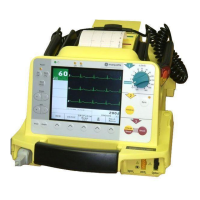Defibrillation Electrodes
8 Marquette Responder® 3000 227 490 02-C
Defibrillation Electrodes
SHOCK
3
CHARGE
2
APEX
Figure 2-2. Hard paddle
a
d
bc
Figure 2-3. Electrode for internal defibrillation
Figure 2-4. Disposable adhesive electrode
(external defibrillation, pacing)
Hard Paddles
Hard paddles are the electrodes commonly used
for external, transchest defibrillation. There is a
special Apex paddle and a Sternum paddle.
For delivery of the defibrillation shock, the
paddles are placed directly on the body surface.
Before use, however, an ample amount of
electrode gel must be spread onto the paddles.
Both paddles have a shock button: The shock
button on the Apex paddle is used to initiate
defibrillator charging; afterwards the defibrillation
shock is triggered by pushing both shock buttons.
The paddles can also be used to acquire the ECG
signal.
A smaller contact surface for defibrillation of
children is integrated in the paddles (see "Defi-
brillation of Children" in section 4.2).
Electrodes for Internal Defibrillation
Electrodes for internal defibrillation consist of a
contact spoon (
a
, Figure 2-3), a handle
b,
and a
counter nut
c
.
The spoon must match the size of the heart and
have full contact with the myocardium. There is a
choice of 3 different spoon sizes.
The electrodes as well as their connection cable
must be sterilized before each use.
An internal defibrillation is either performed with
two
spoon electrodes or with
one
spoon electrode
and a so-called "external counter electrode" (
d
,
Figure 2-3) which is placed under the patient and
in the immediate vicinity of the heart.
Defibrillator charging and release of the defibril-
lation shock are initiated with buttons on the
device.
Disposable Adhesive Electrodes
Disposable adhesive electrodes are used both for
defibrillation and for pacing. These electrodes are
self-adhesive and pregelled. They are connected by
means of a special cable and may remain attached
to the patient for a maximum of 24 hours.

